Readings Newsletter
Become a Readings Member to make your shopping experience even easier.
Sign in or sign up for free!
You’re not far away from qualifying for FREE standard shipping within Australia
You’ve qualified for FREE standard shipping within Australia
The cart is loading…






Clarence W (Cap) Wigington was a man of firsts – the first registered African American architect in Minnesota and the first African American municipal architect in the nation. The public buildings that he designed for the city of St Paul are a continuing legacy, helping to define the city’s character. And his achievements, both as an architect and as a leader in the state’s African American community, are all the more significant given the limitations of the times in which he lived. Wigington’s most ephemeral work may have been his most creative. From 1937 to 1947, he designed six ice palaces and a number of secondary structures for St Paul’s famous Winter Carnival. These stunningly fanciful designs are Wigington’s most imaginative and exuberant. Alternating chapters by Taylor and Larson examine the man, his times, his leadership in the African American community, and his architectural work. Richly illustrated with photos of Wigington’s buildings and his drawings, the book also contains a list of works attributed to Wigington. His life story shows the struggles and the achievements of a talented individual facing and conquering long odds.
$9.00 standard shipping within Australia
FREE standard shipping within Australia for orders over $100.00
Express & International shipping calculated at checkout
Clarence W (Cap) Wigington was a man of firsts – the first registered African American architect in Minnesota and the first African American municipal architect in the nation. The public buildings that he designed for the city of St Paul are a continuing legacy, helping to define the city’s character. And his achievements, both as an architect and as a leader in the state’s African American community, are all the more significant given the limitations of the times in which he lived. Wigington’s most ephemeral work may have been his most creative. From 1937 to 1947, he designed six ice palaces and a number of secondary structures for St Paul’s famous Winter Carnival. These stunningly fanciful designs are Wigington’s most imaginative and exuberant. Alternating chapters by Taylor and Larson examine the man, his times, his leadership in the African American community, and his architectural work. Richly illustrated with photos of Wigington’s buildings and his drawings, the book also contains a list of works attributed to Wigington. His life story shows the struggles and the achievements of a talented individual facing and conquering long odds.